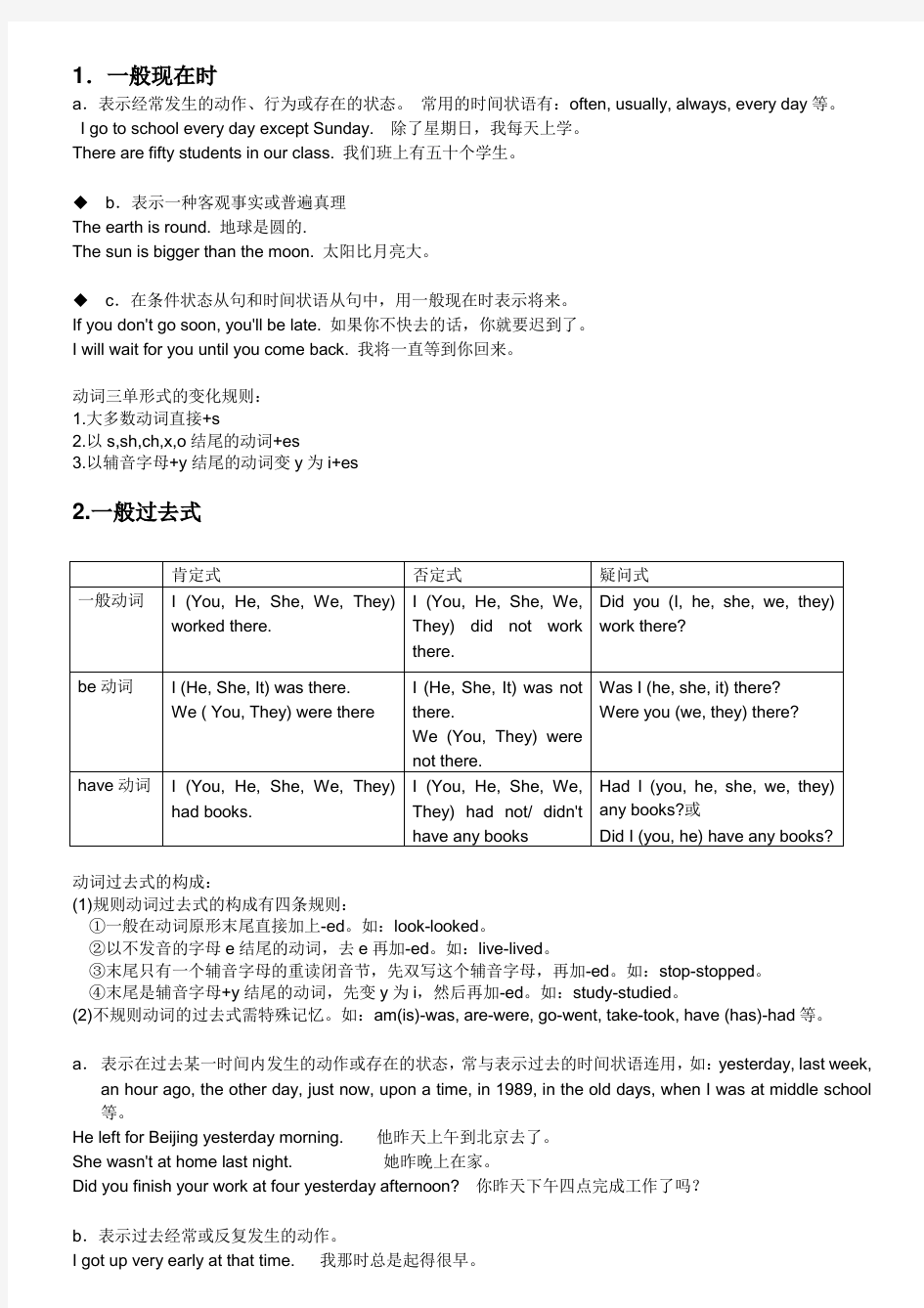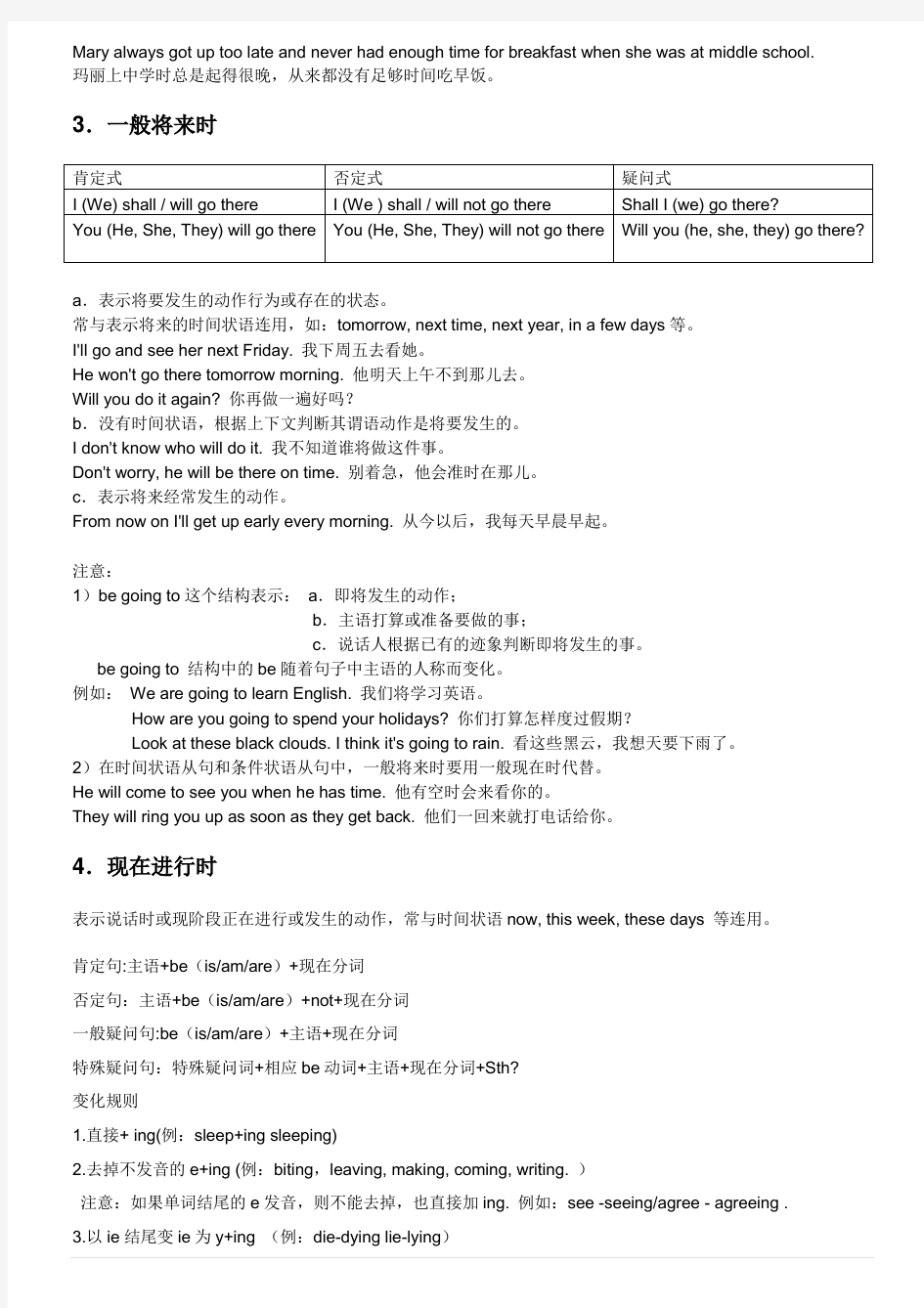(完整版)中考英语八大时态讲解归纳


1.一般现在时
a.表示经常发生的动作、行为或存在的状态。常用的时间状语有:often, usually, always, every day等。
I go to school every day except Sunday. 除了星期日,我每天上学。
There are fifty students in our class. 我们班上有五十个学生。
◆b.表示一种客观事实或普遍真理
The earth is round. 地球是圆的.
The sun is bigger than the moon. 太阳比月亮大。
◆c.在条件状态从句和时间状语从句中,用一般现在时表示将来。
If you don't go soon, you'll be late. 如果你不快去的话,你就要迟到了。
I will wait for you until you come back. 我将一直等到你回来。
动词三单形式的变化规则:
1.大多数动词直接+s
2.以s,sh,ch,x,o结尾的动词+es
3.以辅音字母+y结尾的动词变y为i+es
2.一般过去式
动词过去式的构成:
(1)规则动词过去式的构成有四条规则:
①一般在动词原形末尾直接加上-ed。如:look-looked。
②以不发音的字母e结尾的动词,去e再加-ed。如:live-lived。
③末尾只有一个辅音字母的重读闭音节,先双写这个辅音字母,再加-ed。如:stop-stopped。
④末尾是辅音字母+y结尾的动词,先变y为i,然后再加-ed。如:study-studied。
(2)不规则动词的过去式需特殊记忆。如:am(is)-was, are-were, go-went, take-took, have (has)-had等。
a.表示在过去某一时间内发生的动作或存在的状态,常与表示过去的时间状语连用,如:yesterday, last week, an hour ago, the other day, just now, upon a time, in 1989, in the old days, when I was at middle school 等。
He left for Beijing yesterday morning. 他昨天上午到北京去了。
She wasn't at home last night. 她昨晚上在家。
Did you finish your work at four yesterday afternoon? 你昨天下午四点完成工作了吗?
b.表示过去经常或反复发生的动作。
I got up very early at that time. 我那时总是起得很早。
Mary always got up too late and never had enough time for breakfast when she was at middle school. 玛丽上中学时总是起得很晚,从来都没有足够时间吃早饭。
3.一般将来时
a.表示将要发生的动作行为或存在的状态。
常与表示将来的时间状语连用,如:tomorrow, next time, next year, in a few days等。
I'll go and see her next Friday. 我下周五去看她。
He won't go there tomorrow morning. 他明天上午不到那儿去。
Will you do it again? 你再做一遍好吗?
b.没有时间状语,根据上下文判断其谓语动作是将要发生的。
I don't know who will do it. 我不知道谁将做这件事。
Don't worry, he will be there on time. 别着急,他会准时在那儿。
c.表示将来经常发生的动作。
From now on I'll get up early every morning. 从今以后,我每天早晨早起。
注意:
1)be going to这个结构表示:a.即将发生的动作;
b.主语打算或准备要做的事;
c.说话人根据已有的迹象判断即将发生的事。
be going to 结构中的be随着句子中主语的人称而变化。
例如:We are going to learn English. 我们将学习英语。
How are you going to spend your holidays? 你们打算怎样度过假期?
Look at these black clouds. I think it's going to rain. 看这些黑云,我想天要下雨了。
2)在时间状语从句和条件状语从句中,一般将来时要用一般现在时代替。
He will come to see you when he has time. 他有空时会来看你的。
They will ring you up as soon as they get back. 他们一回来就打电话给你。
4.现在进行时
表示说话时或现阶段正在进行或发生的动作,常与时间状语now, this week, these days 等连用。
肯定句:主语+be(is/am/are)+现在分词
否定句:主语+be(is/am/are)+not+现在分词
一般疑问句:be(is/am/are)+主语+现在分词
特殊疑问句:特殊疑问词+相应be动词+主语+现在分词+Sth?
变化规则
1.直接+ ing(例:sleep+ing sleeping)
2.去掉不发音的e+ing (例:biting,leaving, making, coming, writing. )
注意:如果单词结尾的e发音,则不能去掉,也直接加ing. 例如:see -seeing/agree - agreeing . 3.以ie结尾变ie为y+ing (例:die-dying lie-lying)
4. 对于重读闭音节词,双写末尾字母再加ing. 例如:sitting, beginning, getting, putting, running, stopping cutting, controlling
a.表示说话时谓语的动作正在进行。
Who are you waiting for? 你在等谁?
He knows that we are helping him now. 他知道我们现在正在帮助他。
b.在现阶段正在进行的动作,但不一定说话时动作正在进行。
The students are working on the farm there days. 这些天学生们正在农场劳动。
c.有些动词的进行时态还可用来表示将来时。这类动词有go, come, leave, arrive, move, die等。
He is coming soon. 他不久就要来了.
Mary is arriving here at 4 o/clock this afternoon. 玛丽今天下午四点到达这里。
注意:
1)表示状态或感觉的动词,如:know, love, like, want, hear, see, think等,一般没有进行时态,因为它们不能表示正在进行的动作。但是,如果词义发生变化,能表示一个正在进行的动作,也可使用进行时态。
Stop, I am thinking. 停下来,我正在想问题呢。
2)无法延续动作的动词,如:jump, begin, start, stop等一般不宜用于进行时态。但是,若想表示动作反复或即将发生,也可使用进行时态。
He is jumping up and down. 他一下一下地跳个不停。
5.过去进行时
表示过去某个时刻或过去一段时间正在进行的动作。常与表示过去的时间状语如:then at that time, once, a moment ago等连用,或者用另一动作表示过去的时间。
I was writing a letter at home at seven yesterday evening. 我昨晚七点在家写信。
He was watching TV when I came home yesterday evening. 当我昨晚回家的时候他正在看电视
一般疑问句及答语:Was/Were+主语(You/he/she/they/we)+doing+其它
Yes,I was./No,I wasn't.
Were you playing basketball at four yesterday afternoon? 昨天下午四点你们在打篮球吗?
特殊疑问句=特殊疑问词+was/were+主语(I/you/he/she/they/we)+doing+其它
6. 现在完成时:
基本结构:主语+have/has+ done
①肯定句:主语+have/has+ done+宾语.
②否定句:主语+have/has+ not+ done+宾语.
③一般疑问句:Have/Has+主语+done+宾语.
肯定回答:Yes,主语+have/has.
否定回答:No,主语+haven't/hasn't .
④特殊疑问句:特殊疑问词+一般疑问句(have/has+主语+done+其他)
用法:1.常与for(+时间段),since(+时间点或过去时的句子)连用.
①for+时段为…时间②since+过去一个时间点(译为:自从……以来)③since+时段+ago
④since+从句(过去时)⑤It is+时段+since+从句(过去时)
标志词:already(肯定), yet(否定,疑问), just, before, recently, ever, never, ...times(次数).
◆瞬间性动词可表示某一动作的完成但是当后面有表示一段时间的状语时要变成相应的延续性动
词
◆瞬间性动词改为延续性动词:
have (has) been to +某地,表示到过某地,说明去过某地,说话时已经回来了。
have (has) gone to +某地,说明去某地了,说话时还没有回来。
7. 过去完成时:
基本结构:主语+had+ done
①肯定句:主语+had+ done
②否定句:主语+had+not+ done
③一般疑问句:Had+主语+ done?
肯定回答:Yes,主语+had. 否定回答:No,主语+had not .
④特殊疑问句:特殊疑问词+ 一般疑问句(Had+主语+done)?
⑤被动语态:主语+had(hadn't)+been+ done
用法:A 由时间状语来判定。
(1) by + 过去的时间点。I had finished reading the novel by nine o'clock last night.
(2) by the end of + 过去的时间点We had learned over two thousand English words by the end of last term.
(3) before + 过去的时间点。They had planted six hundred trees before last Wednesday.
B.由“过去的过去”来判定。过去完成时表示“过去的过去”,是指过去某一动作之前已经发生或完成的动
作,动作在前的用过去完成时,在后的用一般过去时。
◆(1) 宾语从句中,当宾语从句的主句为一般过去时,且从句的动作先于主句的动作时,从句要用过去完成时。在told, said, knew, heard, thought等动词后的宾语从句
She said that she had seen the film before.
(2) 状语从句中,在时间、条件、原因、方式等状语从句中,主、从句的动作发生有先后关系,动作在前的,要用过去完成时,动作在后的要用一般过去时。
After he had finished his homework, he went to bed.
注意:before, after 引导的时间状语从句中,由于before 和after 本身已表达了动作的先后关系,若主、从句表示的动作紧密相连,则主、从句都用一般过去时。
After he closed the door, he left the classroom.
(3) 表示意向的动词,如hope, wish, expect, think, intend, mean, suppose等,用过去完成时表示"原本…,未能…" We had hoped that you would come, but you didn't.
8. 过去将来时
1)构成
过去将来时由助动词should或would加动词原形构成。
2)用法
a.用于从过去某一时间来看将要发生的事情。常用在宾语从句中表示从句的动作发生在主句动作之后。They said they would go to visit the second factory.
他们说他们将要去参观第二个工厂。
The teacher told us that there would be a concert the next Tuesday.
老师告诉我们下周二将要有场音乐会。
b.过去将来时也可由“was / were going to + 动词原形”来表示。
She said she was going to see her uncle.
她说她要去看望她的叔叔。
c.有些动词的过去进行时也可表示过去将来时。
I didn't have much time to talk with you became I was leaving for Shanghai in two hours.
我没有多少时间跟你谈话了,因为再过两个小时我就要动身去上海。
注意:
“would+动词原形”有时并不表示过去将来时,而表示一种客气的请求。
Would you please open the window?
